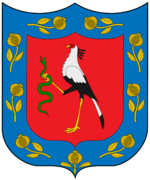Darona
Federal Republic of Darona Respublica Foederaló Daroná | |
|---|---|
| Motto: "Fortitudo in Adminicula" "Strength in Community" | |
| Anthem: "A Patrio, A Omnio" | |
| Capital and largest city | Arganti |
| Official languages | Daronian |
| Demonym(s) | Daronian |
| Government | Federal Parliamentary republic |
| Francisco Arella | |
| Legislature | National Congress |
| Senate | |
| Chamber of Deputies | |
| Independence from X | |
• Declared | 7 May 1819 |
• 9 August 1832 Expansion | 26 January 1943 Dictatorship |
| 29 May 1972 | |
| Population | |
• 2022 census | 47,789,890 |
| GDP (PPP) | 2022 estimate |
• Total | $1.294 trillion |
• Per capita | $28,990 |
| GDP (nominal) | 2022 estimate |
• Total | $781.1 billion |
• Per capita | $16,970 |
| Gini (2022) | medium |
| HDI (2022) | very high |
| Currency | Daronian Quaesta (DQS) |
| Time zone | UTC-1 |
| Date format | dd/mm/yyyy |
| Driving side | right |
The Federal Republic of Darona is a sovereign state in southern !America and shared a border with X to the south, X to the east, X and X to the north. Darona has an extensive coastline to the west along the X Ocean. The capital and largest city in Darona is Arganti which is located in the northern part of the country inland on the Ovenna river on the plain of Ovenna. Other major settlements in Darona include Porto Ferusa, Terlanta and Sabrenno on the south west coast in what is known as the western urban belt and further inland the northern cities of Mareva and Colpera.
Indigenous peoples began to settle what today is known as Darona 12,000 years ago. The first settlers from !Europe explored the region in the early 1600s and the land around the Western coast and what is today known as the Ovenna valley was claimed by X. The colonial stronghold over the territory increasingly became seen as overbearing by the populace of what was then Darona and certain intellectuals in the colony established an ideology centred around a free republican Darona with democratic and liberal ideals. This sparked a series of revolts and revolutions which initially granted further autonomy for the colony however in the early 19th century the revolutionary ideas of the previous century re-emerged in a new generation and this led to what is known to most Daronians as The Great Revolution after which in 1819 full autonomy was achieved. Following independence the already strong economy in the region boomed with cross ocean trade and in 1832 Darona purchased as well as annexed vast swathes of land east of its original colonial territory to its east. This happened over the course of five years and is referred to as the great expansion. Darona began as a democratic state up until 1943 when a severe economic crisis and the subsequent depression occurring in its aftermath leading to violent unrest and the overthrow of the elected government by military leaders. This military dictatorship would last up until 1983 with the peaceful revolution restoring democracy.
Darona is a developed country and ranks highly in measures of human development and has a high standard of living. Following the end of dictatorship in 1983 and emergence from geopolitical isolation Darona has become an increasingly important player on the international stage and a key regional power and influence.


